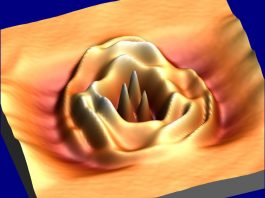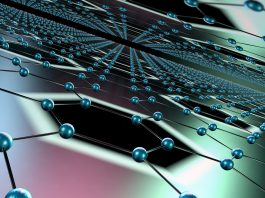Extraordinary phenomenon labelled the quantum anomalous Hall effect has been discovered in bilayer graphene.
Researchers at The University of Texas in Dallas, along with collaborators in Germany, have for the first time observed an extraordinary phenomenon known as the quantum anomalous Hall effect in a simple material such as graphene. Previous experiments have identified it only in complex or delicate materials.
The study, published on Oct 6 in the journal Nature, demonstrates the exotic behaviour in bilayer graphene, which is a naturally occurring, two-atom thin layer of carbon atoms arranged in two honeycomb like lattices stacked together.
Quantum Hall effect
The quantum Hall effect is a macroscopic phenomenon in which the transverse resistance in a material changes by quantised values in a stepwise fashion. It occurs in two-dimensional electron systems at low temperatures and under strong magnetic fields. In the absence of an external magnetic field, however, a 2D system may spontaneously generate its own magnetic field, such as through an orbital ferromagnetism that is produced by interactions among electrons. This behaviour is defined the quantum anomalous Hall effect.
Dr Fan Zhang, associate professor of physics in the School of Natural Sciences and Mathematics, explains that “when the rare quantum anomalous Hall effect was investigated previously, the materials studied were complex. By contrast, our material is comparably simple, since it just consists of two layers of graphene and occurs naturally.”
Dr Thomas Weitz, an author of the study and a professor at the University of Göttingen, said, “Additionally, we found quite counterintuitively that even though carbon is not supposed to be magnetic or ferroelectric, we observed experimental signatures consistent with both.”
Ground states in quantum mechanics and quantum statistics
Zhang predicted in research published in 2011, that bilayer graphene would have five competing ground states, the most stable states of the material that occur at a temperature near absolute zero (minus 273.15 degrees Celsius or minus 459.67 degrees Fahrenheit). Such states are determined by the mutual interaction of electrons whose behaviour is governed by quantum mechanics and quantum statistics.
“We predicted that there would be five families of states in bilayer graphene that compete with each other to be the ground state. Four have been observed in the past. This is the last one and the most challenging to observe,” Zhang explained.
In experiments depicted in the Nature article, the researchers found eight different ground states in this fifth family that exhibit the quantum anomalous Hall effect, ferromagnetism and ferroelectricity simultaneously.
“We also showed that we could choose among this octet of ground states by applying small external electric and magnetic fields as well as controlling the sign of charge carriers,” Weitz said.
Potential low-dissipation quantum information applications
The ability to control the electronic properties of bilayer graphene to such a high degree might make it a potential candidate for future low-dissipation quantum information applications. Although Zhang and Weitz believe they are primarily interested in revealing the “beauty of fundamental physics.”
“We predicted, observed, elucidated and controlled a quantum anomalous Hall octet, where three striking quantum phenomena — ferromagnetism, ferroelectricity and zero-field quantum Hall effect —can coexist and even cooperate in bilayer graphene,” Zhang added. “Now we know we can unify ferromagnetism, ferroelectricity and the quantum anomalous Hall effect in this simple material, which is amazing and unprecedented.”
Other authors of the Nature article include UT Dallas physics doctoral student Tianyi Xu and researchers from the University of Göttingen and the Ludwig Maximilian University of Munich.
Zhang’s research is funded by the U.S. Army Combat Capabilities Development Command’s Army Research Laboratory and the National Science Foundation.









